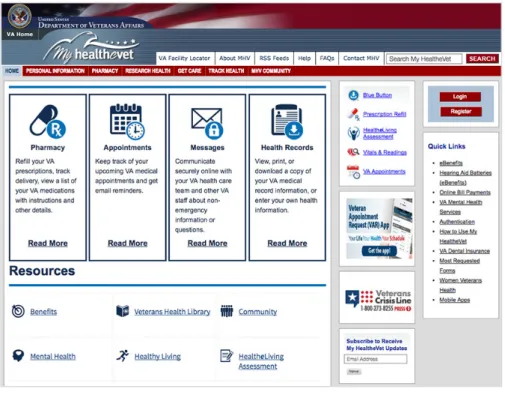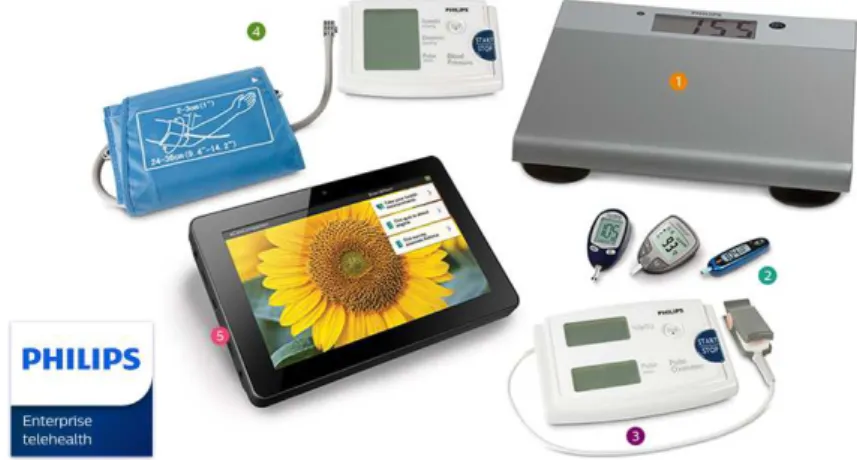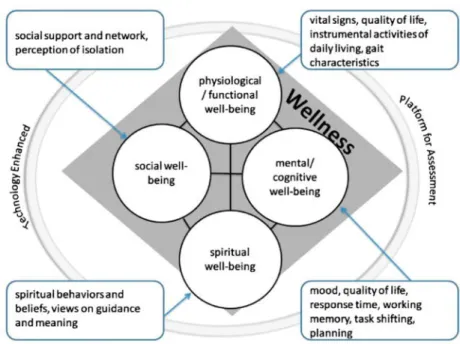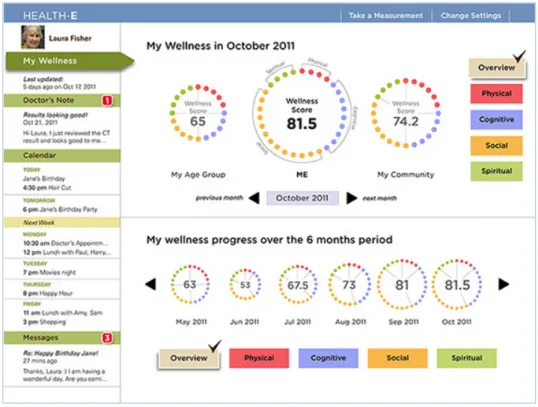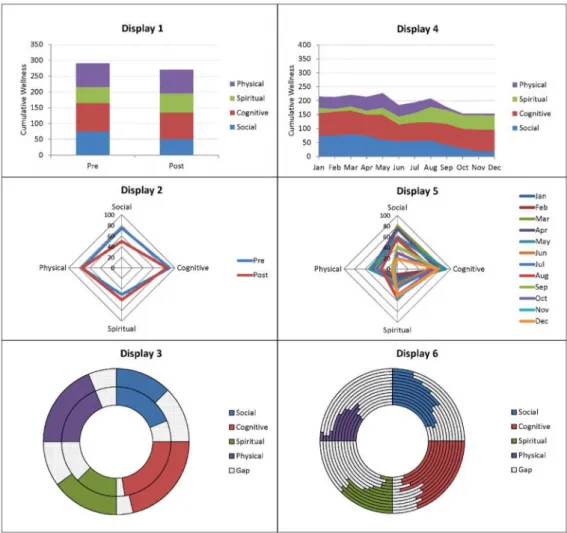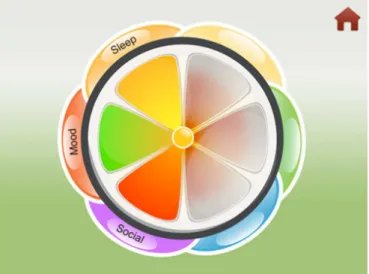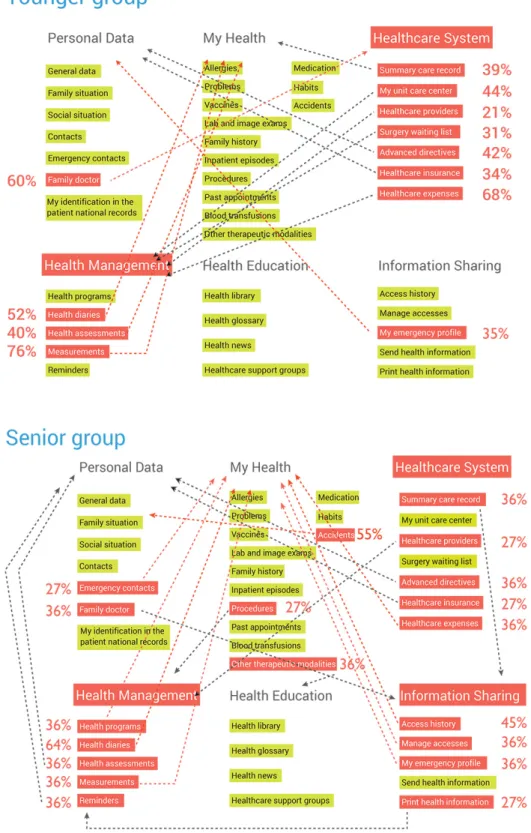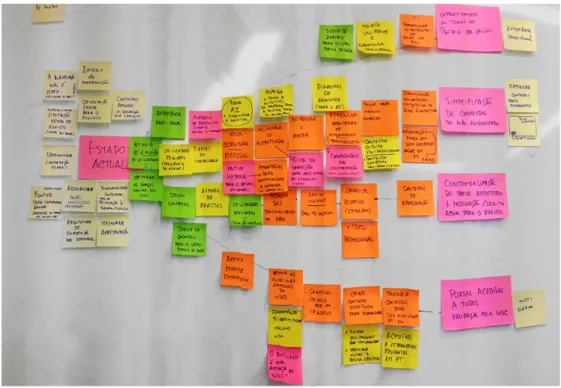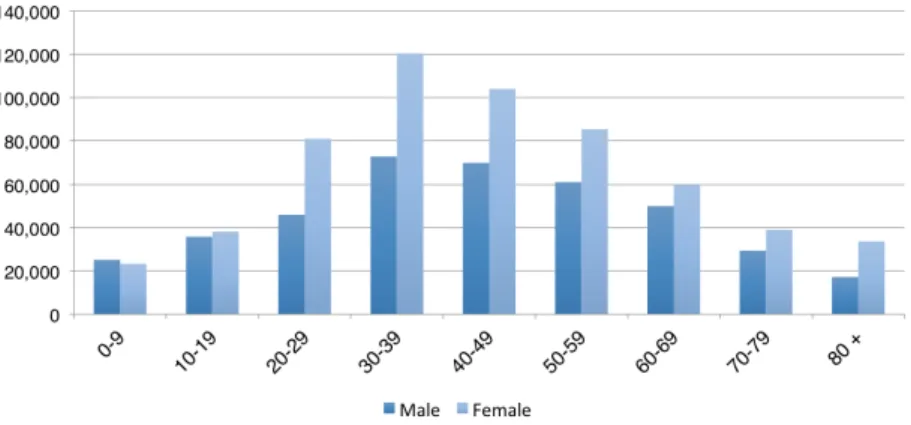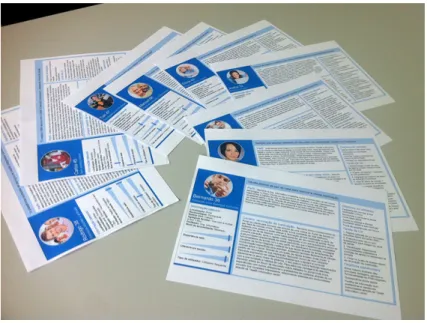Inês Martins Sequeira Rodolfo Licenciatura em Design de Comunicação
Design Strategy for Integrated Personal
Health Records:
Improving the User Experience of Digital
Healthcare and Wellbeing
Dissertação para obtenção do Grau de Doutor em Media Digitais
Outubro de 2017
Prof. Doutor Luís Manuel Marques da Costa Caires
Prof. Doutor José Colucci Prof. Doutor Daniel Jorge Viegas Gonçalves
Prof. Doutora Bo Xie
Prof. Doutora Teresa Isabel Lopes Romão Prof. Doutor António Fernando
Vasconcelos Cunha Castro Coelho
Prof. Doutor Nuno Manuel Robalo Correia Presidente:
Arguente(s): Vogal(ais): Júri:
Professor Doutor Carlos Alberto Pacheco dos Anjos Duarte, Professor Auxiliar, Faculdade de Ciências da Universidade de Lisboa Professor Doutor Nuno Manuel Robalo
Correia, Professor Catedrático, Faculdade de Ciências e Tecnologia da Universidade Nova de Lisboa
Orientador:
Design Strategy for Integrated Personal Health Records: Improving the user experience of digital healthcare and wellbeing
Copyright © Inês Martins Sequeira Rodolfo, Faculdade de Ciências e Tecnologia, Universidade Nova de Lisboa.
Dedication
to my great grandmother, a Spanish woman who built our future with her stamina,
to my grandmother, a strength of nature at the age of 97 years old,
to my mother, an artist, a teacher and devoted caregiver, who has warmed our hearts with her paintings,
to my father, a problem-solving mind, engineer and photographer, and his craving for humans to reach their full potential,
PhD Program
Acknowledgements
I remember the day I left my last job as a UX designer, to pursue this PhD. When I left the headquarters of Nokia Siemens Networks, the sky was alive with a beautiful sunset. At that time, I already had in mind what would be the quest of my thesis. By chance, on the way to my car, I came across an elderly man who was lost on the freeway and fell down, next to me. Naturally, I guided this man to the company’s doorman who explained that this person suffered from Alzheimer’s and it wasn’t the first time he was lost on that freeway. I remember the feeling I had. I was sure, I was making the right decision and perhaps the work I was about to begin, could provide its contribution for improving the quality of care, by empowering people to self-manage their health and wellbeing, avoiding this type of events.
I would like to acknowledge the following colleagues from the team at Nokia, who encouraged me, to follow this quest, Hugo Matinho, Luís Confraria, Ricardo Rafael, Orlando Remédios, Henrique Figueiras, Ricardo Marques, Gonçalo Gomes, Luís Pista, Oliver Stache and Stefan Vaillant. I really appreciated their confidence in me.
I was fortunate to find the best advisors to guide me on this journey. Without their support, leadership and tolerance, this PhD, would not have succeeded. My supervisor, Nuno Correia, was a daily mentor, with whom the research work always flew smoothly. He provided all the necessary resources, so I could fulfill the goals of this thesis. During this time, Nuno Correia adopted a persuasive way to challenge me on following the best practices within the scientific community. I am grateful for all the lessons learned, planning methods, work steps and the availability to always answer my requests. Also importantly, for the good spirit, perseverance and friendship, which kept me going, through all the milestones I faced.
grateful for all the dedicated and enriched reviews, references, brainstorming meetings, as well as the availability and provided resources. I believe that the combined skills of both my advisors, were fundamental in accomplishing the work plan that was initially proposed.
This PhD owes its initiative to the Program UT Austin | Portugal to which I would like to thank for the opportunities offered to the researchers in the field of Digital Media. In particular, special thanks to Sharon Strover, Nuno Correia, Rosental Alves, Karen Gustafson, Pedro Madeira, Conceição Capelo and Carolina Enes. To my colleagues of the program, I would like to thank them for their companionship, especially to Moisés Coelho, Filipa Pires, Guida Casella, Ana Jorge, Diana Marques, Fernando Nabais and Carla Nave. A special thanks to Filipa Pires for her friendship, allowing me to connect with my higher self, so I could reach the top of the hill when it was most steep.
I would also like to thank Fundação para a Ciência e Tecnologia, for funding my PhD grant SFRH/BD/51819/2012. Likewise, to NOVALINCS, the Department of Informatics of Universidade Nova de Lisboa, for the additional funding to complete my work and for providing me a workplace with the available resources. To all my colleagues at the lab, I would like to thank their support for sharing their knowledge and research practices with me, especially to Filipa Peleja, the bravest girl and researcher I met at the lab, to the advices shared by Rui Jesus and Rui Madeira and to the companionship of André Sabino, Sofia Reis, Carmen Morgado, Diogo Cabral, Bruno Cardoso, Jorge Costa, Pedro Santos, Tiago Santos and Miguel Lourenço. A special thanks to Rui Nóbrega for his friendship, who followed me during the achievements and barriers of my work, providing important insights that helped me gradually evolve as a researcher.
I am very grateful to the valuable contribution of Gonçalo Dias da Silva, who worked with me at the lab, in the second use case study of this thesis, making the work possible to be tested, developing his master thesis in collaboration with this PhD.
I would also like to thank the staff members of the lab to who I call “the three godmothers of the department” – Susana Pereira, Anabela Duarte and Sandra Rainha.
The other lab center I would like to thank, is the department of Human-Computer-Interaction at LASIGE of Faculdade de Ciências da Universidade de Lisboa, with which I interacted with a few people. A special thanks to José Coelho, who exchanged with me his knowledge and expertise in user interfaces for elderly citizens. I would also like to thank Fábio Rito, who collaborated in the first use case study of this thesis.
of this work. First, my special thanks to Doctor Liliana Laranjo, who I worked with, closely and actively, in the first part of this thesis, having contributed with her clinical research expertise to the Integrated PHR design model.
I give my acknowledgments to both the organizations, connected to the Portuguese Ministry of Health that assisted with this PhD, providing access to their facilities, workflow procedures and access to data base sources.
I am grateful to SPMS - Serviços Partilhados do Ministério da Saúde, and to all the project team members of the PDS – Portuguese Data Sharing Platform, who interacted with this research. I would like to thank Professor Henrique Martins for opening this door and a special thanks to Marta Cannas Silva e Sousa for her efforts on making this collaboration possible and meaningful for both parties.
I am also grateful to LCS - Linha de Cuidados de Saúde, and to all the people involved in the National Senior Telehealth Program - Saúde 24 Sénior, who interacted with this research, both the physicians and the nursing staff. In the same way, I would like to thank the Administrator of LCS, Luís Pedroso Lima, for opening this door and a special thanks to Professor Doctor Carlota Louro, who actively mentored this collaboration and without whom, this project could not have achieved its end. Moreover, for her concern that went beyond the project, supporting me to overcome difficult hurdles. Also, to Doctor Rui Almeida, who provided all the clinical material necessary to our collaboration and enriched our project with his vision; and to the supervisor nurse of the program, Pedro Simões, for enabling and helping with the recruitment of the nurses and seniors who took part in the research.
This PhD also benefited from the networking that derived from NOVAhealth research group initiative, founded by Pedro Pita Barros. In this group, my very special thanks go to Professor Doctor Amália Botelho, who has dedicated her professional life to create such a meaningful geriatric tool called MAB – Método de Avaliação Bio-Psico-Social, which we explored in our work. I would like to thank her for the support and inspiration and also for assuring that I would safely keep on the right track.
To conclude, I would like to thank the Senior University we worked with -Universidade São João de Deus, for enabling the recruitment of senior people who participated in the research. In particularly, to Francisca Moura and Constança Fialho Tojo.
Finally, family are always present during a lifetime of a PhD, as well as naturally, in all other things in life that we go through. But this one was a wild ride, wasn’t it? So…thank you Chico and Lena, for being always there for me and for your endurance, you are indeed, the best parents in the world (cliché fits you well). Thank you Siloca, for your support and love in hardest times. Also, to my friends Elisabete, Daniela, Paula, Melissa and Lin, thank you for your companionship and encouragement. My cat is also part of the story, so thank you as well for standing by my side during the writing.
Abstract
This dissertation addresses the timely problem of designing Integrated Personal Health Records (PHR). The goal is to provide citizens with digital user experiences, sustainable and flexible enough, for gaining control over their personal health information in a seamless way. Most importantly, so that people are able to reflect and act upon their self-knowledge, towards the accomplishment of their good health and wellbeing. Towards this end, the Integrated PHR as an emerging model in the field of Health IT, was the framework that set this research forward on exploring how communication and collaboration between patients and providers can be improved, which naturally impacts the field of HCI.
Acknowledging that today patients are the ones who own all that is recorded about their health data, this new model was object of a design strategy that shaped the results presented in this dissertation. These have showed how patients can have more control of their health over time, through a patient-centered, organic system, which has the ability of combining multiple sources of data both from patient and provider side. As this new type of PHR fosters the creation of integrated networks, this milestone was achieved in this research by interacting with cross-channel user experiences that took part of nationwide healthcare ecosystems.
proposal of the portal by also creating a foundational model for designing Integrated PHRs. The second part in collaboration with the Portuguese National Senior Telehealth Program (Saúde 24 Sénior), led to another proposal for an Integrated PHR, applying the outcomes from Part 1 and the requirements that derived from the findings explored in this second use case study. The proposed solution, has the potential to be used by the Portuguese senior community in the scope of home assistive care.
Both proposals applied a user experience design methodology and included the development of two prototypes. The engagement of the stakeholders during the two case studies was accomplished with participatory design methods and followed a multidisciplinary approach to create solutions that would meet the human, politics and behavior interdependencies that were inherent to the process of working with large healthcare organizations.
Resumo
Esta dissertação aborda o problema oportuno da criação de Processos de Saúde Pessoais Integrados (PHR integrado). O objetivo é proporcionar aos cidadãos experiências de utilização digitais, suficientemente sustentáveis e flexíveis, para que estes possam obter um maior controlo sobre as suas informações de saúde pessoais de uma forma simples e natural. Mais importante ainda, para que as pessoas possam refletir e agir sobre o seu autoconhecimento, na busca de alcançarem uma boa saúde e bem-estar. Para este fim, o PHR integrado como modelo emergente no campo dos sistemas de informação de saúde, foi a estrutura que impulsionou esta investigação na exploração sobre como a atual comunicação e a colaboração entre os pacientes e os prestadores de cuidados pode ser melhorada, o que naturalmente tem impacto no campo da Interação Pessoa Máquina.
Tendo consciência e assumindo que hoje os pacientes são os detentores de toda a informação de saúde que é registada sobre si, este novo modelo foi objeto de uma estratégia de design que moldou os resultados apresentados nesta dissertação. Estes demonstraram como os pacientes podem ter um maior controlo sobre a sua saúde ao longo do tempo através de um sistema orgânico centrado no paciente, que tem a capacidade de combinar múltiplas fontes de dados que têm origem tanto do lado do paciente como dos prestadores de cuidados. Como este novo tipo de modelo promove a criação de redes integradas, este marco foi alcançado nesta investigação através da interação com experiências transversais multi-canal que tiveram lugar em ecossistemas de saúde de âmbito Nacional.
A primeira parte, em colaboração com o Portal Nacional do Utente que contém um PHR integrado, faz parte da Plataforma Portuguesa de Dados de Saúde (PDS) e pode ser utilizado por qualquer cidadão Português. Este caso de estudo deu origem a uma proposta para o portal, acabando por constituir também um modelo fundacional para a criação de PHR integrados. A segunda parte, em colaboração com o Programa Nacional Sénior de Telesaúde em Portugal (Saúde 24 Sénior), deu origem a uma proposta para o desenvolvimento de outro PHR Integrado, aplicando os resultados da Parte 1 e os requisitos que derivaram dos resultados explorados neste segundo caso de estudo, com o potencial de ser utilizado pela comunidade sénior portuguesa no âmbito da teleassistência em casa.
Ambas as propostas aplicaram uma metodologia de user experience design, e contemplaram o desenvolvimento de dois protótipos. O envolvimento dos stakeholders durante os dois casos de estudo foi promovido através de diversos métodos de design participativo, seguindo uma abordagem multidisciplinar de forma a criar soluções que respondessem às interdependências humanas, políticas e comportamentais, inerentes ao processo colaborativo com organizações de saúde, de grande dimensão.
As contribuições que resultaram desta tese, pretendem fazer parte de um processo de transição que visa alterar o comportamento do sector da saúde, que procura cada vez mais, melhorar a relação entre o paciente e o médico, promover a participação do paciente na sua saúde, a prestação de cuidados colaborativos, aplicando o conceito de
Contents
Acknowledgements ... iii
Abstract ... vii
Resumo ... ix
Contents ... xi
List of Figures ... xv
List of tables ... xvii
Abbreviations ... xix
Introduction ... 1
1.1. Background ... 2
1.2. The Integrated Personal Health Record ... 5
1.3. Seniors as a potential group for adopting Integrated PHRs ... 7
1.4. Measuring wellbeing in Integrated PHRs ... 9
1.5. The design of Integrated PHRs for Senior Telehealth environments ... 10
1.6. Research Questions ... 12
1.7. Research Contributions ... 13
1.8. Thesis Publications ... 17
1.9. Thesis Partnerships ... 18
1.10. Thesis Collaborations ... 18
Literature Review ... 21
2.1. Healthcare System trends ... 21
2.2. PHR definition, formats and history ... 24
2.3. PHR pervasive features ... 29
2.4. PHR research directions ... 31
2.5. AAL technology for seniors ... 34
2.6. Self-monitoring for the senior wellbeing ... 37
2.6.1 Visualization techniques ... 39
2.7. Seniors online accessibility ... 42
2.8. Extensive literature review for features collection ... 43
2.8.1 Electronic healthcare services ... 45
2.8.2. Patient Education ... 51
2.8.3. Self-monitoring tools ... 54
2.8.4. Information Sharing ... 56
Research methods domain ... 61
PART I ... 63
4.1. Use Case Scope ... 64
4.2. The Portuguese National Patient Portal ... 65
4.3. Research work ... 67
4.3.1 Creating a foundational model for the Patient Portal ... 69
4.3.2 Enhancing the user experience of the citizens ... 70
4.4. User Research ... 71
4.4.1. Participatory Expert Review ... 71
4.4.2. Users Mental Models ... 74
4.4.2.1. Restructure of the Information Architecture ... 77
4.4.3. Backcasting ... 79
4.4.4. Stakeholders Interviews ... 82
4.4.4.1 Product Strategy ... 83
4.4.4.1 Marketing ... 84
4.4.4.2 Service and content design ... 84
4.4.4.3 User experience ... 85
4.4.4.4 Product development ... 86
4.4.4.5 Customer support ... 86
4.4.5. Web analytics ... 86
4.4.6. User Groups and personas ... 89
4.5. Design Model Proposal ... 93
4.5.1. Application information structure ... 94
4.5.2. User Interface Design ... 94
4.5.2.1. Dashboard and Header ... 95
4.5.2.2. Personal data ... 97
4.5.2.3. My Health ... 98
4.5.2.4. Health Monitoring ... 101
4.5.2.5. Healthcare Providers ... 103
4.5.2.6. Schedule ... 104
4.5.2.7. Health Education ... 104
4.5.2.8. Information Sharing ... 104
4.5.2.9. Public area ... 105
4.6. Prototype Development ... 107
4.7. Results ... 113
PART II ... 117
5.1. Use Case Scope ... 118
5.2. The Portuguese National Senior Telehealth Program ... 119
5.3. Geriatric Assessment Model ... 120
5.4. Research work ... 121
5.5. User Research ... 124
5.5.1. Stakeholders and seniors Interviews ... 124
5.5.1.1. Creating a specialized nation-wide telehealth phone-line for senior citizens ... 126
5.5.1.2. Identifying senior user groups ... 127
5.5.1.3. Potential users of the online channel ... 128
5.5.1.4. What has been the phone-line experience ... 128
5.5.1.5. Moving towards personalised care ... 130
5.5.1.6. Enabling provider’s data to the seniors ... 131
5.5.1.7. Enabling self-assessments to the seniors ... 131
5.5.1.8. The role of family participation: concerns on perception ... 132
5.5.1.9. The web as a continuous follow-up channel ... 133
5.5.1.10. How can both channels (phone and web) be integrated ... 135
5.5.1.11. Displaying ICP results to the seniors ... 135
5.5.1.12. Identifying which PHR tools can better support seniors ... 136
5.5.2. Generative and field research ... 140
5.5.2.1. Contextual inquiries ... 140
5.5.2.2. Participatory design sessions ... 143
5.6. Design Model Proposal ... 146
5.6.1. Application Structure ... 147
5.6.2. User Flow diagrams ... 148
5.6.2.1. Registration process ... 148
5.6.2.2. Service first contact ... 149
5.6.3. User Interface Design ... 150
5.6.3.1. User profile ... 150
5.6.3.2. Dashboard ... 151
5.6.3.3. My Health Assessments ... 153
5.6.3.4. Health Monitoring ... 159
5.6.3.5. Call scheduling ... 160
5.6.3.6. Health Education ... 160
5.6.3.7. Information Sharing ... 161
5.6.3.8. Smartwatch app ... 162
5.7. Prototype Development ... 163
5.8. Usability Testing ... 164
5.8.1. Evaluation Methodology ... 165
5.8.2. Participants ... 166
5.8.3. Findings ... 168
5.8.3.1. Use Case 1 - Create user profile ... 168
5.8.3.2. Use Case 2 - Explore the dashboard ... 169
5.8.3.3. Use Case 3 - Access to the last global health assessment ... 174
5.8.3.4. Use Case 4 - Access to the assessments history ... 180
5.8.3.5. Use Case 5 - Perform a self-assessment and access to educational material ... 182
5.8.3.6. Use Case 6 - Self-monitoring ... 184
5.8.3.7. Use Case 7 - Access call scheduling ... 186
5.8.3.8. Use Case 8 - Sharing data with the National Patient Portal ... 187
5.8.3.9. Task completion success rate and errors report ... 188
5.8.3.10. Post-questionary test ... 189
5.9. Results ... 193
5.9.1. Learning curve of H24 Senior app ... 196
5.9.2. How holistic assessments can be displayed to seniors ... 196
5.9.3. Self-assessments as an empowerment tool ... 197
5.9.4. Reflections on engagement and gamification features ... 197
5.9.5. Evolving the program to a cross-channel user experience ... 198
Conclusion ... 201
Future work ... 209
References ... 217
Appendix ... 233
A. Beta version of the Portuguese National Patient Portal ... 234
A.1 Home page beta version of the Portuguese National Patient Portal ... 234
A.2 Integrated PHR “Health data” ... 235
A.3 Integrated PHR User Interface for associating the citizen card ... 236
B. Stakeholders semi-structured interviews – Part 1 ... 237
C. Card Sorting remote study ... 247
Study participant’s welcome page ... 247
Final short questionnaire ... 249
D. Visual Design Proposal for the Patient Portal Public Area ... 250
E. Visual Design Proposal for the Patient Portal Integrated PHR ... 251
Summary dashboard view ... 251
My Health (first time view) ... 253
Adding a new medication: selection stage ... 253
Adding a new medication: Medication take specification ... 255
My Health (fulfilled) ... 256
Health Monitoring ... 257
E. Semi-structured interviews – Part II ... 258
F. MAB Self-Assessment Questions ... 272
G. Usability Testing Script ... 275
H. Participants Consent Form ... 279
I. Final Questionnaire ... 280
J. Integrated PHR design model documentation ... 282
J.1 Functional Analysis of the Patient Portal ... 282
J.2 Information Architecture of the Patient Portal ... 282
J.3 Mockups of the Patient Portal ... 282
J.4 Personas of the Patient Portal ... 282
J.5 Video tutorial for the Patient Portal proposal ... 282
List of Figures
Figure 1: Danish eHealth Patient Portal. ... 23
Figure 2: Microsoft Health Vault PHR. ... 25
Figure 3: My HealtheVet Patient Portal. ... 27
Figure 4: Patients Like Me healthcare social network. ... 29
Figure 5: Philips eCare Companion, a telehealth app that patients access in a tablet and use to share information with their care team. The app connects to a weight scale, wireless Glucose Meter Accessory, Pulse Oximeter and Blood Pressure. ... 35
Figure 6: The framework for a technology enhanced assessment of older adults’ wellness based on Hoyman’s wellness model [41]. ... 38
Figure 7: Radial plot representation of holistic wellness for older adults. Overall radius of the plot represents wellness score. Social, physical, cognitive, and spiritual components of wellness are modeled [99]. ... 39
Figure 8: Three visualisation techniques for the assessment of integrated health and wellbeing of older adults [97]. ... 40
Figure 9: YourWellness feedback wheel with each segment representing a parameter of wellbeing [46]. ... 41
Figure 10: Overview of the highlighted conflict cards in the IA that show divergent values above 20% for both user groups. ... 78
Figure 11: Final Information Architecture. ... 79
Figure 12: Backcasting workshop setting at SPMS facilities. ... 80
Figure 13: Backcasting mapping result. ... 81
Figure 14: Demographic distribution of the registered users by age and gender with associated household family members. ... 87
Figure 15: Page visualizations of the Portal demonstrate higher accesses on Sundays, decreasing during the week until Friday. ... 88
Figure 16: Users distribution across Portugal are located in or near the largest cities of Lisbon and Porto. ... 88
Figure 17: Distribution of personas by the stakeholders during a workshop with SPMS team. ... 89
Figure 18: Persona for Senior people user group. ... 92
Figure 19: Persona for householders user group. ... 92
Figure 20: Proposal for the application information structure of the Portuguese National Patient Portal. ... 94
Figure 21: Dashboard summary view mockup. ... 96
Figure 22: Dashboard timeline view mockup. ... 97
Figure 23: Advanced directives in Personal data mockup. ... 98
Figure 24: Basic information in My Health mockup. ... 99
Figure 25: Adding medication in My Health Mockup. ... 100
Figure 26: Measurements in Health Monitoring mockup. ... 101
Figure 27: Schedulling an appointment in My providers mockup. ... 103
Figure 28: Access Management in Information sharing mockup. ... 105
Figure 29: Complete home landing page from the online Portal. ... 108
Figure 30: Search providers page (top) and Login page (bottom). ... 109
Figure 31: Application dashboard. ... 110
Figure 32: My Health section. ... 111
Figure 33: Monitoring section. ... 112
Figure 35: Celebration of the Public area redesign presented at a “Forum on Healthcare Innovation” in April
2015. ... 115
Figure 36: New registrations in the Patient Portal three months before and after the public area launch in December 23rd of 2014. ... 116
Figure 37: Preferential educational material for the nurses, physicians and seniors. ... 137
38: Preferential self-tracking tools for nurses and physicians. ... 138
Figure 39: Paper version of the results of an Individual Care Plan, displayed through a polygonal diagram to the nurses. ... 141
Figure 40: Participatory design sessions with the nurses and physicians. ... 145
Figure 41: Proposal for the application information structure of the web channel ‘H24 Senior app’ for the Portuguese Telehealth Senior Program ... 147
Figure 42: Registration process flow diagram. ... 148
Figure 43: Service first contact flow diagram. ... 149
Figure 44: User profile registration form. ... 151
Figure 45: Dashboard Care Plan view. ... 152
Figure 46: Dashboard Monitoring view. ... 153
Figure 47: Chart A (top) and chart B (bottom) of last assessment. ... 154
Figure 48: Summary of my condition and phone calls follow up timeline. ... 155
Figure 49: Expanded recommendations and the quality of care evaluation. ... 156
Figure 50: Timeline view (top) and chart evolution view (bottom). ... 157
Figure 51: Self-assessment questionnaire. ... 158
Figure 52: Measurements section in Health monitoring. ... 159
Figure 53: Call scheduling. ... 160
Figure 54: Health Education. ... 161
Figure 55: Information Sharing. ... 162
Figure 56: Smartwatch app three-step user interface. ... 162
Figure 57: Client-server structure model of H24 Senior app. ... 163
Figure 58: Genre (left) and if live alone or accompanied (right). ... 167
Figure 59: Frequency of Internet use and used devices. ... 167
Figure 60: participant answering to her family context during the user profile registration. ... 169
Figure 61: Histograms of responses to script questions of the task ‘Interpret care plan view’. ... 170
Figure 62: Histograms of responses to two of the script questions of the task ‘Interpret Monitoring view’. ... 173
Figure 63: User responding to a mood notification. ... 174
Figure 64: Chart A (left side) and chart B (right side). ... 175
Figure 65: Participant answering to recommendations. ... 178
Figure 66: Participants submitting a comment. ... 179
Figure 67: Histogram of response to script questions of the task ‘Interpret chart evolution view’. ... 181
Figure 68: Participant performing a self-assessment. ... 182
Figure 69: Histogram of responses to one of the script questions of the task ‘User feedback on self-assessment’. ... 183
Figure 70: Participant measuring her heartbeat through a smartwatch. ... 185
Figure 71: Histograms of responses to script question of the task ‘Monitor heartbeat’. ... 186
Figure 72: Evaluation results of the six domains of UEQ tool. ... 190
Figure 73: Mean of the 3 pragmatic and hedonic quality aspects of UEQ tool. ... 190
Figure 74: Histogram of responses to post-questionnaire focused on the application context and domain. .. 191
List of tables
Table 1: Participants demographics from the study divided into younger and senior user groups. The table
also includes the environment where the study was run, task time performance and timeframe duration. .... 76
Table 2: MAB tool - Method for Assessing the Bio-Psycho-Social Wellbeing of the Senior ... 121
Table 3: Macrodimensions and microdimensions of the Global Health Assessment. ... 144
Table 4: Participants demographics ... 166
Table 5: Total of participants who completed each task successfuly represented in percentage. ... 188
Abbreviations
AAL Ambient Assisted Living
CN# Communicator Nurse (participant number)
EHR Electronic Health Record
EPR Electronic Patient Portal
EMR Electronic Medical Record
eHealth Electronic Health
GP General Practitioner
GHA Global Health Assessment
HCI Human Computer Interaction
Health IT Health Information Technology
IA Information Architecture
ICP Individual Care Plan
LCS Linha de Cuidados de Saúde
MAB Method for Assessing the Bio-Psycho-Social
NHS National Healthcare System
ODL Observations of Daily Living
PHR Personal Health Record
PDS Portuguese Data Sharing Platform
PCEHR Personally Controlled Electronic Health Record
SPMS Serviços Partilhados do Ministério da Saúde
SDT Self Determination theory
S# Senior (participant number)
UX User Experience
UI User Interface
Introduction
‘Tree of life’ by Helena Caldeira
User experience is a well known recognized paradigm in the design and evaluation of artifacts in the human computer interaction field. Its methods have been used in design science to gain a more comprehensive understanding of the user, providing them valuable experiences [200]. Several user experience studies reported in literature, seek to complement the functional analysis and user interaction of systems, with other emotional, social and cultural aspects of relationships that people have with technology [2]. Nevertheless, it has been a challenge for health communication within the domain of information technology to meet these criteria,
When we value individual and community knowledge and autonomy, the leaves are golden.
as there is a lack of involving the beneficiaries of a product, system or service in the design process, resulting on a gap in what concerns meeting the needs of the users [128]. The research presented in this dissertation, is concerned with the enhancement of health communication in peoples lives and also on filling this gap. The main goal of health communication is to empower people with evidence-based information about living a healthy life [128]. As a keynote in HCI 2016, Alan Dix presented in his talk, ways for designers to leverage the power of the large to bring benefits to the small, privileging the information stored at the edges as primary, rather than central repositories. While presenting “The Leaves are Golden - putting the periphery at the center of information design”1, Alan Dix established a metaphor regarding the design of traditional information systems which often focuses on centralization, privileging global consistency over local knowledge, as following: “the golden copy is at the center, data at leaves are views of this.” This metaphor stands along with the goal of this thesis, which is to put the citizen and their own data at the heart of the healthcare information system.
1.1.
Background
Ageing is one of the greatest challenges of the 21st century society. We are witnessing an increased demand of delivery of care, due to an important demographic shift of the population growth. Globally, population aged 60 or over is growing faster than all younger groups. Compared to 2017, the number of persons aged 60 or above is expected to more than double by 2050 and the number of persons aged 80 or over is projected to triple [216]. In addition, by 2020 there will be a considerable decline in the number of the nursing staff and in the specialized geriatric workforce [144], thus demanding for new measures to ensure that this fast growing group receives proper care [196]. Fostering good health is a determinant factor to enhance the senior’s independency and functionality, helping them to age in place [215] [214]. Undoubtedly, this asks assistive technology and customized solutions to support older people. That is the prompt of several programs around the world such as the European Innovation Partnership on Active and Healthy Ageing. Also, tailored technologies for seniors have proven to positively impact on quality of life, by reducing costs, readmissions and the length of hospital inpatient episodes [87].
Within this scope, given these increasing demands for improved care, Health Information Technology (Health IT) or Electronic Health (eHealth) that supports health-related human activities, is seen as a key enabler to achieve such a demand for improved efficiency and quality of care [55]. Health IT collects, stores, and displays patient health data that can improve accuracy and collaboration in service delivery resulting in better care [115]. We are facing a transition period that is changing the way healthcare system practices behave today and consequently, affecting peoples’ lives: Health IT is moving towards a strategy of transparency and continuity of care with the Electronic Patient Record (EPR) at the core. The time has come where medical records are now digital and incorporated into Electronic Health Records (EHRs), which are hold by healthcare facilities, becoming part of a fast, increasing, pervasive world. In its turn, EHRs can significantly enhance teamwork among clinical professionals by improving information transfer, workflow and communication that consequently affects positively patient safety. Meadows and Chaiken [119] explain how patient care can take clear advantages of clinical information technology solutions. Accordingly, they assert that for high-quality and safe patient care, multidisciplinary teams of professionals are required to work synergistically, remain focused and have appropriate communication channels for sharing patient information among them. Gaps in effective communication may result on professionals to work at cross-diagnosis and treatments, which can lead to suboptimal care and compromised patient safety. Therefore, Health IT or eHealth plays an important role in clinical teamwork. A given example by the authors shows that with the use of a clinical documentation system, such as the EHR, clinicians can complete charting in real time at the point of care in a way that complements their workflow. Information automatically posts to the multidisciplinary record of care so it is instantly available to all care team members. In addition, key patient data are available for clinical decision support during the ordering process. Given the scenario, physicians, nurses and others can now focus on activities that truly affect patient care rather than those that are associated with clinical or administrative rework.
information exchange strategy for sustainability. Nevertheless, unlike other sectors, very little is regulated at European level in terms of harmonizing health systems and services [52]. Sustainable system innovations or transitions towards sustainability require combinations of technological, cultural, social, institutional and organizational changes that are only possible with stakeholders co-operation [154]. In this context, several government reforms are conducting technological implementation guidelines, with the main goal to empower patients in the control of their health data and engage them in communication with their providers. However, an early study conducted by Symon et al. (1996) [188], for example, points towards issues on politics and conflicts frequently associated with large-scale implementations. The causes for the problems are varied as healthcare work is highly institutionalized and complex, involves multiple stakeholders, takes place across primary, secondary and tertiary care sectors and depended on a highly collaborative approach [55]. A very common concern is regarding the poorly integration of the several systems that support different practices, departments and institutions, which makes coordination a very difficult task. Other studies [175] [55] also suggest that the challenges of implementing new technology in healthcare settings are very complex, diverse and locally situated which inevitably affects the design process for these novel solutions. It depends on organizational, clinical but also human/politics/behavior interdependencies that are the key challenges for design and implementation in clinical practice.
Accordingly, both the European Union’s Data Protection Acts and HIPAA - Health Insurance Portability and Accountability Act, in the United States, state that patient’s data are owned by the patient and not by the institutions [5]. This is a very important change in mindset: giving the citizens the ownership of their data enables an easier and more ethical way of sharing health data with others. In fact, if citizens own their data, they become case managers of their own medical record and may better decide upon their treatments. Acknowledging this ownership, leads to an enhancement of the person’s self-care awareness and decision-making, by providing the person, the access to her clinical history. Moreover, who would be more interested to manage oneself data? The holder of the data or the providers who are responsible for doing their care work, but have many other patients to manage in their busy daily clinical practice?
improve patient-provider relationships, enhance shared decision making and enable a more personalized patient centered care, helping also to decrease healthcare costs [9] [12] [71]. While EHRs are populated with providers inputs that allow the patient’s medical record to be shared across an institution (reporting clinical episodes, diagnosis, care plans and treatments), PHRs are particularly centered on patient self-collected data. PHRs belong to the group of personal informatics systems and wellness devices. They are flexible solutions to access the patient’s data anytime, anywhere, providing patient context awareness, monitoring and response to emergency or critical situations [3]. The main advantage however, is to allow users to obtain self-knowledge by collecting information about oneself like one’s behavior or habits and be able to reflect on them. Li et al. [103] created a stage-based model of personal informatics systems composed of five stages that can be applied in the design of a PHR: preparation, collection, integration, reflection and action. Preparation stage concerns itself with people’s motivation to collect personal information, how they determine what information they will record, and how they will record it. Collection stage is the time when people collect information about themselves. Integration is the stage that lies between the Collection and Reflection stages, where the information collected is prepared, combined, and transformed for the user to reflect on. The Reflection stage is when the user reflects on their personal information. This stage may involve looking at lists of collected personal information or exploring or interacting with information visualizations. Last, the Action stage is when people choose what they are going to do with their newfound understanding of themselves. Some people reflect on the information to track their progress towards goals.
Finally, the evolution of Personal Health Records in Health IT, shows opportunities and challenges for bridging clinical and non-clinical health practices in the field of HCI. There has been a growing interest in the HCI community to study Health, with particular focus in understanding healthcare practices and designing technologies to support and to enhance these practices [29].
1.2.
The Integrated Personal Health Record
decision making [43]. The novelty of this model is to have a system that gathers patient information recorded from the provider side, and its multiple health-related sources, and the patient side, which can be accessed by both parties but to be managed by the patient who is responsible for its sharing. The provider side includes the several stakeholders that the patient interacts with: nurses, physicians and therapists, among the others who take part of any healthcare environment. In order to be populated with provider’s data such as the patient medical record, the system needs to be flexible enough, to connect with other medical systems e.g., being tethered to an EHR from an independent facility or being tethered to a broader healthcare network like a National Patient Portal. Likewise, a single Integrated PHR can detail all the related interactions that occur between patient and providers, and lead to better treatment and seamless healthcare by always being online and up to date. Also, the model helps to increase organizational control and strict auditing (what information was recorded, when and by whom), controlled by the patient.
standardized and streamlined, and some of which need to be more informal and flexible). Finally, the design of Integrated PHR should enable the creation and review of records that may need to change over time to account for new or adaptive measures for monitoring chronic conditions.
Another two concepts relevant to the design and development of this model also emerge in this context: (1) The contribution of the system to a new paradigm in the healthcare industry introduced by the movement of “participatory medicine”. The paradigm motivates patients and providers to work together as a team, focusing on the person’s health improvement [5]. (2) The system as an engine of human behavior change, allowing health outcomes to be measured and collected through self-tracking tools, either automated (sensor-based) or manual (user inputs). This behavior is defined as “Human measurement-based medicine” that helps providers to make care choices while simultaneously, engages people to make life choices and achieve wellness goals [67]. This can be accomplished with the wide prevalence of smartphone self-tracking applications that are available today (e.g., MyFitnessPal, WeightWatchers) and wearable sensing devices (e.g., Fitbit, Apple Watch, Microsoft Band). Chung et al. [26] have presented how providers recognize the value and benefit of self-tracking data to help achieve five major goals: (1) Supporting diagnosis, (2) Personalizing treatment, (3) Increasing motivation and accountability - help patients to overcome motivational barriers and be accountable for their health issues, (4) Learning about patients and (5) Facilitating discussion and managing visits.
The design and adoption of Integrated PHRs to answer the needs presented so far, is the main motivation that structures this dissertation. Towards a perspective of patient centered care, the research work describes a design strategy that was followed for designing Integrated PHRs. The goal was to create a design model that could engage the citizens to participate in their own health, allowing them to work together with their providers across institutions, towards the accomplishment of their wellness.
1.3.
Seniors as a potential group for adopting Integrated
PHRs
context of the users and its condition-specific requirements is highly necessary to engage patients and providers in this new model. As suggested in prior work, a potential user group to adopt Integrated PHRs, are senior people [211] [9] [89]. This is mainly because this group often experiences several care problems at the same time, as a result of the human ageing process (e.g., chronic diseases, visual impairment, hearing loss and dementia). Indeed, this is one of the main reasons for this group to broadly benefit from an integrated digital tool that can help people to manage their problems and prevent critical events.
Additionally, this group is the most affected by the fragmentation and incompleteness of medical records, which in many cases is still a reality, despite the advances of EHRs [9]. Senior people as well as people with long-term conditions, are considered to be the most vulnerable to the inevitable decentralization of health information caused by non-interoperable systems of facilities [174]. Likewise, as they often need to go through several care transitions, moving between facilities or providers during their care treatments, the management of all their data can be quite a challenge. Uncoordinated transitions that happen most of the times, can imperil patients because of omitted, duplicative or contradictory care plans [174] [181]. For instances, communication problems with handoffs in hospitals, where patient information is exchanged between healthcare providers (e.g. during a hospital department transfer), may cause adverse events that can lead to medical errors instead of assuring the continuity of care [70]. Besides these care transitions, the fact that senior people suffer from memory loss, makes them vulnerable to forget important clinical information and past episodes. Accordingly, 40 to 80 % of the medical information provided by the clinicians during a visit is forgotten immediately and almost half the information that patients remember is incorrect [5].
has been acknowledged in many previous efforts under names like participatory design [129] [63], user centered [157] or co-design [209].
The other motivation that derives from the circumstantial socio-demographic context we are living today, which inevitably impacts the future of the citizen wellbeing, is the design of digital user experiences focused on senior people, in the field of Health IT. Starting with the foundation of how an Integrated PHR should be, this thesis is then concerned in conducting user research and testing with senior people as a potential user group of these platforms. More specifically, the work presented in this thesis aims to understand what are the particular needs of this group to use the system and evaluate their desirability of adoption.
1.4.
Measuring wellbeing in Integrated PHRs
1.5.
The design of Integrated PHRs for Senior Telehealth
environments
A literature review to assess the effectiveness of technologies applied to assist seniors, highlighted the major age care problems, targeted by researchers [87]: dependent living, fall risk, chronic disease, dementia, social isolation, depression, poor well-being and poor medication management. While Health IT was shown to have good results in reducing social isolation and enhancing wellness, Telehealth was considered to be the only technology to assist seniors with chronic disease showing significant improvements in the prevention of health conditions. Moreover, sensor technology was also reported to improve fall risk among other benefits, with the potential to enrich Telehealth solutions. Initially, voice communication via telephone or radio, was used to solicit the opinion of a doctor in the case of an emergency, but the potential of telehealth (or telemedicine) was boosted by the widespread introduction of information technologies into the healthcare sector with the capability of offering new services [59] [200]. Home Telehealth is described as “the use of telecommunications by a home care provider to link patients or customers to one or more out-of-home sources of care information, education, or service by means of telephones, computers, interactive television, or some combination of each’’ [94].
Interestingly, older adults recognize the utility of Telehealth systems [40]. Also, it has been reported in several studies to date that they accept well technology, enjoy self-monitoring and home Telehealth increases their sense of security [17] [106] [148]. An increasing interest from individuals for aging in place, rather than in an institution, is another driving force that turns Telehealth into one of the fastest growing areas of healthcare provision [94] [162]. Likewise, the dissemination of Telehealth programs enables the urgent need for seniors to access timely acute care [170]. However, socio-economic disparities among this group need to be studied as they can affect the ability to use a system or device [144]. Alongside, guidelines and standards for the design of Telehealth monitoring applications should also be regarded under special consideration [106]. The availability of personal data obtained within Telehealth systems also supports the concept of a PHR [40], yet these have still made limited use of patients’ access to medical records and the integration with community services.
care outside hospitals, moving health services into the patient’s homes, helping senior people to age in place. We found Telehealth to meet this purpose.
All together, the presented motivations of this introduction, took this thesis to explore the following summarized, main goals:
> Promote coordinated and integrated care in Health IT by facilitating communication between the citizen and healthcare providers across the different healthcare environments through the use of an Integrated PHR.
> Define a design strategy for the Integrated PHR new model: merge in a unique system, care records from providers with self-collected data from the person, studying how both sides can be integrated.
> Support the citizen life choices with self-collected data from the Integrated PHRs and provide more patient knowledge to healthcare providers in order to support their care choices.
> Improve patient-provider relationship and patient engagement.
> Improve the user-friendliness service delivery of the healthcare system.
> Design a valuable, accessible and credible user experience for the senior’s ongoing participation in the decision-making process of their healthcare and wellbeing through the use of an Integrated PHR.
> Study multidimensional holistic views for the senior wellbeing in a self-awareness approach.
1.6.
Research Questions
From the presented research goals, three questions outline the work of this thesis as follows:
(Q1) How can we combine and represent health data from different sources, into Integrated Personal Health Records to improve the user experience of the citizen healthcare?
This research question focus on providing a contribution for the foundation of the Integrated PHR that aims to improve health communication, in people lives. To accomplish so, it is necessary to identify, according to literature review, which existing PHR features are relevant to the design model, which new features are needed, and how they should be designed. For a sustainable integration of these features, we need to understand which information can be complementary and which data relationships can bring insights for the decision-making in self-care. The goal is to give a full picture to the citizen about all interactions that are concerned to their health, over time, as well as to enable electronic healthcare service tools to easily manage those interactions (e.g., schedule an appointment). As such, the research will look at ways of combining self-collected data (observations of daily living) with data collected by providers (e.g., patient medical record) in order to shape the system functional analysis, information architecture and user interface design.
(Q2) Which PHR features are most effective in improving healthcare outcomes in
senior people?
thoughts and behaviors” [68]. ODLs can be related to the report of health events such as symptoms, concerns, sleep quality, mood, or ease of doing daily tasks. An example of tools to measure ODLs are patient diaries (e.g., symptom diaries) or geriatric assessments (reporting physical, mental and social functioning) that result on follow up care plans, according to the measures results.
In quantitative data, we will look at manual or automated logs that measure and track health such as blood pressure and falls. Tools for measuring objective data have the potential of connecting health platforms with sensor devices, providing real time information that may alert users and its providers for critical conditions.
(Q3) How can we create a valuable user experience that may enhance the senior’s
healthcare self-awareness, while simultaneously engage them to work together
with their providers towards the achievement of their wellbeing?
Taking into account human factors, this is a broader exploratory question that aims to map the cognitive, psychological and social characteristics of senior people, their way of thinking, their motivations and emergent needs regarding the participation in their healthcare. We first want to know how data should be displayed to seniors according to their mental models. We will look at holistic views that can integrate patient generated data. We will also look at communication channels and healthcare environments that may support seniors to live independently in their homes. Finally, we also want to understand how far seniors wish to adopt an Integrated PHR.
1.7.
Research Contributions
This section consists of an overview of the research work, presenting its contributions, and how it was documented in the structure of this thesis. The research work is divided into two parts, presented in the document respectively, as
Stakeholders included project managers, developers, physicians and nurses. Before the stages are presented, we describe a Literature Review in Chapter 2 and the thesis Research Methodology in Chapter 3.
The first stage consists on the design strategy for an Integrated Personal Health Record, presented in Part 1 of dissertation. This stage collaborated with the Portuguese National Patient Portal that covers about 1.100.000 users (by the time of our study), with the potential of covering the overall country’s population of nearly 10 million citizens. More specifically, the patient portal launched in 2012, combines an Integrated PHR, that served as a use case for this work, raised by Research question Q1.
The Portal takes part of a cross-channel user experience of the PDS - Portuguese Data Sharing platform. The PDS combines the Patient Portal with a Health Professional Portal that receives data from more than 370 institutions. The platform has been taking the first steps to avoid scattered electronic health records across the several Portuguese facilities from the National Healthcare System (NHS). The Use Case Scope of this stage is detailed in Section 4.1.
The Portuguese Patient Portal as a use case scenario, was an opportunity to develop the proposal of an Integrated PHR design model for the following reasons: (1) It allows patient data to be shared across all healthcare facilities of the NHS through the unique summary care record, reporting all interactions with the healthcare system. All providers who the citizen interacts with contribute to the summary care record enhancing team collaboration work, amongst them. (2) Gives the citizen the ownership of their data, by providing its access, as well to the summary care record populated by the providers (3) the citizen contributes with patient generated data to the providers of the NHS, improving patient knowledge in care decision making. (4) The portal supports the citizen in managing their health by the use of electronic services (e.g., schedule an appointment), self-tracking and educational tools.
In this context, the first main contribution of this thesis is the proposal of a foundational design model for Integrated PHRs, inspired by the study of the Portuguese National Patient Portal. The Design Model Proposal is detailed in Section 4.5. The proposal was also derived from an Extensive Literature Review
contemplate the design of an Integrated PHR. This contribution involves the following achievements available in the corresponding sections, respectively:
> Which set of heuristics in HCI field, are most appropriate to evaluate healthcare applications. Section 4.4.1.
> What are the lessons learned with real users of a Nation-wide platform, from the study of their online behavior and interaction with the stakeholders from the teams of project management, development, marketing and customer support. Section 4.4.5.
> Understand what are the potential user groups of Integrated PHRs (what are their characteristics and engagement level with the system), which take part of a Nation-wide healthcare network, meaning that its diversity can cover the user profiles of other similar systems, widely or more locally deployed. Section 4.4.6.
> Contribute to the communication strategy of the Portuguese Nation-wide Patient Portal in its integrated context of the PDS, promoting the citizen awareness over the Portal. Impact in the communication public portal by contributing to the increasement of registrations. Section 4.7.
The second stage consists on exploring the design of an Integrated PHR (derived from findings of stage 1), within the scope of a Senior Telehealth Program, presented in Part 2 of this thesis. This stage collaborated with the Portuguese National Senior Telehealth Program (Saúde 24 Sénior) that follows about 24.000 seniors over 70 years old (by the time of our study). The program launched in 2014, aims at identifying and preventing frailty, risk behaviors, minimizing social isolation, promoting healthy behaviors and contributing to a feeling of confidence among the seniors. The overall health status and both environmental and individual domains related to the wellness state of the individual are assessed through a bio-psycho-social geriatric tool. The program comprises regular follow-ups, shifting from weekly to monthly, conducted by nurses who communicate with the seniors through phone calls. The Use Case Scope of this stage is detailed in Section 5.1. The goal of this use case study was to address research questions Q2 and Q3, by exploring also the design and adaptability of an Integrated PHR (derived from findings of stage 1), in an assistive environment that can support senior people to preserve their autonomy, by living independently in their home.
user experience for a Senior Telehealth Program, combining phone, with an Integrated PHR over the web that also connects with a smartwatch device. The goal was to explore how pervasive technology could leverage the telehealth program, by providing to the service, the individual context awareness, monitoring and prevention of critical events. The Design Model Proposal is detailed in Section 5.6. This contribution involves the following achievements available in the corresponding sections, respectively:
> What has been the experience of the Telehealth Program, regarding what are the perspectives and concerns of the communicating nurses, seniors enrolled in the program and how physicians have designed the clinical framework; what are the interest of these stakeholders in adopting a complementary web-channel and how it can be shaped and integrated with the phone line. Section 5.5.1 and Section 5.5.2.
> How the web-channel with an Integrated PHR can enhance the outcomes of the program care delivery by aligning the goals of senior participants with the goals of the service providers; how the explored features of the Integrated PHR, focused on senior people, can enable users to reflect and take control of their healthcare and wellbeing. Section 5.9.
1.8.
Thesis Publications
The research described in this thesis is available in the following publications:
∗ Rodolfo, I., Silva, G., Correia, N., Duarte, C., Louro, C., Botelho., A. (2017). Assessing the Senior Bio-Psycho-Social Wellbeing: The Design of a Cross-channel User Experience for Assessing the Senior Bio-Psycho-Social Wellbeing (conference full paper, under review)
∗ Laranjo, L., Rodolfo, I., Pereira, S. (2017). Adoption of a National Personal Health Record in Portugal - Characteristics of the “‘innovators”. In JMIR Medical Informatics (journal)
∗ Rodolfo, I., Correia, N., Duarte, C., Louro, C., & Almeida, R. Perspectives on User Experience for a Nation-wide Senior Telehealth Program. In Proceedings of the 30th International BCS Human Computer Interaction Conference (HCI 2016). (conference full paper)
∗ Rodolfo, I., Correia, N., Sousa, M., Sá, P., & Duarte, C. (2016, May). How Far in the Future will We Start From?: Interacting with the Stakeholders of a Nation-wide Patient Portal. In Proceedings of the 2016 CHI Conference Extended Abstracts on Human Factors in Computing Systems (pp. 899-909). ACM. (conference case study)
∗ Rodolfo, I. (2016). Improving the senior wellbeing through telehealth support and integrated care. ACM SIGACCESS Accessibility and Computing, (114), 49-52. (conference doctoral consortium)
∗ Rodolfo, I., Laranjo, L., Correia, N., & Duarte, C. (2014, October). Design strategy for a national integrated personal health record. In Proceedings of the 8th Nordic Conference on Human-Computer Interaction: Fun, Fast, Foundational (pp. 411-420). ACM. (conference full paper)
1.9.
Thesis Partnerships
This PhD established two partnership protocols between the Department of Informatics NOVALINCS of Faculdade de Ciências e Tecnologia da Universidade Nova de Lisboa, with two organizations that are conneted to the Portuguese Ministry of Health:
∗ Partnership with SPMS - Serviços Partilhados do Ministério da Saúde (Shared Services of the Portuguese Ministry of Health), in the scope of the Portuguese National Patient Portal of the PDS – Portuguese National Health Data Platform (Plataforma de Dados de Saúde).
∗ Partnership with LCS - Linha de Cuidados de Saúde S.A., in the scope of the Portuguese National Senior Telehealth Program, Saúde 24 Sénior.
1.10.
Thesis Collaborations
The research work presented in this dissertation, has also collaborated closely with the following independent researchers, research groups and universities:
∗ Researcher Gonçalo Dias da Silva, MD: Faculdade de Ciências e Tecnologida da Universidade Nova de Lisboa – Master student in Informatics Engineering, at NOVALINCS - Department of Informatics. Collaborated in his thesis “Sistema Web para Programa Nacional de Telemedicina” that resulted from the project “Saúde 24 Sénior online” in partnership of this PhD with LCS. Responsible for developing the prototype in the use case of this thesis “Portuguese Nationwide Senior Telehealth Program” (Saúde 24 Sénior).
∗ Researcher Fábio Rito, MD: Faculdade de Ciências da Universidade de Lisboa – Researcher at LASIGE, Department of Human-Computer-Interaction. Collaborated in the responsive design development of the prototype for the Integrated PHR model in the use case of this thesis “Portuguese Nationwide Patient Portal with an Integrated PHR” (Portal do Utente).
participatory expert review, extensive literature review and as an MD consultant in the design proposal of the use case in this thesis “Portuguese Nationwide Senior Telehealth Program” (Portal do Utente).
∗ Universidade Sénior São João de Deus, Lisboa: Senior University which collaborated in several studies of the research work presented in this thesis by helping to recruit seniors in the classes of Informatics.
∗ Nova Medical School, Faculdade de Ciências Médicas: Collaborated with Professor Carlota Louro and Professor Amália Botelho, as MD consultants in the second use case of this thesis “Portuguese Nationwide Senior Telehealth Program” (Saúde 24 Sénior).
∗ NOVAhealth research group: This PhD has established collaborations with other researchers between the academic units of Universidade Nova de Lisboa in the domain of health research, more specifically with Nova Medical School. This PhD has participated so far, in the following NOVAhealth workshops:
> Health Informatics Workshop in 29 Apr 2016, presenting “Improving the senior wellbeing through telehealth and integrated care”.
Literature Review
This chapter begins by presenting what are the main healthcare system trends around the world in the scope of Health IT development and health information interoperability and what is the role of PHRs by explaining its definition, type of formats and history. Then, the review provides some examples of pervasive features and research directions of PHRs. This first part is followed by an analysis of devices and integrated solutions for senior people in the scope of assistive technology, how self-monitoring tools can improve the senior wellbeing and finally, what are the online accessibility needs of this group, having in mind the design of PHRs.
The end of this chapter provides an extensive literature review, presenting a collection of features that can form an Integrated PHR. This collection served as a framework in the design of the proposed solutions that are part of this dissertation.
